GMC SAVANA 1997 Owners Manual
Manufacturer: GMC, Model Year: 1997, Model line: SAVANA, Model: GMC SAVANA 1997Pages: 388, PDF Size: 20.17 MB
Page 201 of 388
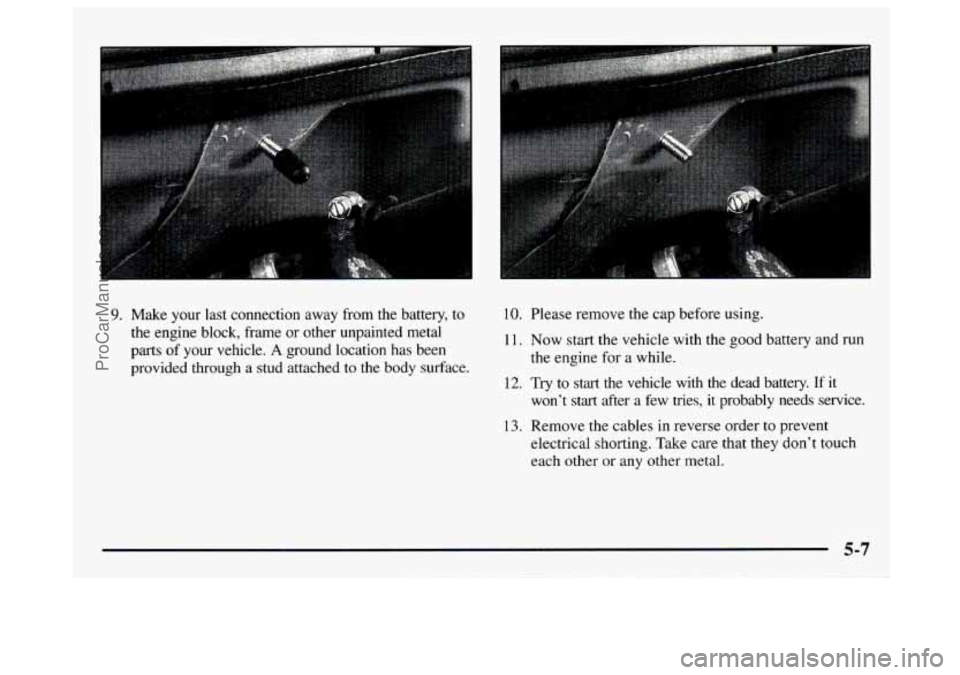
9. Make your last connection away from the battery, to
the engine block, frame or other unpainted metal
parts of your vehicle.
A ground location has been
provided through a
stud attached to the body surface.
10. Please remove the cap before using.
11. Now start the vehicle with the good battery and run
the engine for a while.
12. Try to start the vehicle with the dead battery. If it
13. Remove the cables in reverse order to prevent
won’t start after
a few tries,
it probably needs service.
electrical shorting. Take care that
they don’t touch
each other or any other metal.
ProCarManuals.com
Page 202 of 388
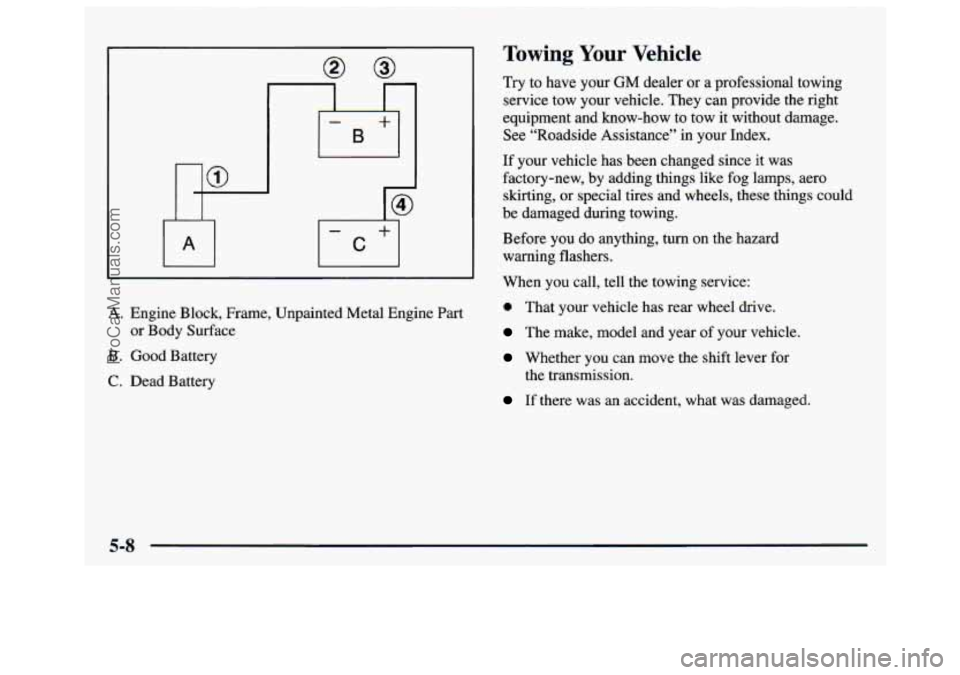
A. Engine Block, Frame, Unpainted Metal Engine Part
or Body Surface
B. Good Battery
C. Dead Battery
Towing Your Vehicle
Try to have your GM dealer or a professional towing
service tow your vehicle. They can provide the right
equipment and know-how to tow it without damage.
See “Roadside Assistance’’ in your Index.
If your vehicle has been changed since it was
factory-new, by adding things like fog lamps, aero
skirting, or special tires and wheels, these things could
be damaged during towing.
Before you do anything, turn on the hazard
warning flashers.
When you call, tell the towing service:
0 That your vehicle has rear wheel drive.
The make, model and year of your vehicle.
Whether you can move the shift lever for
the transmission.
If there was an accident, what was damaged.
5-8
ProCarManuals.com
Page 203 of 388
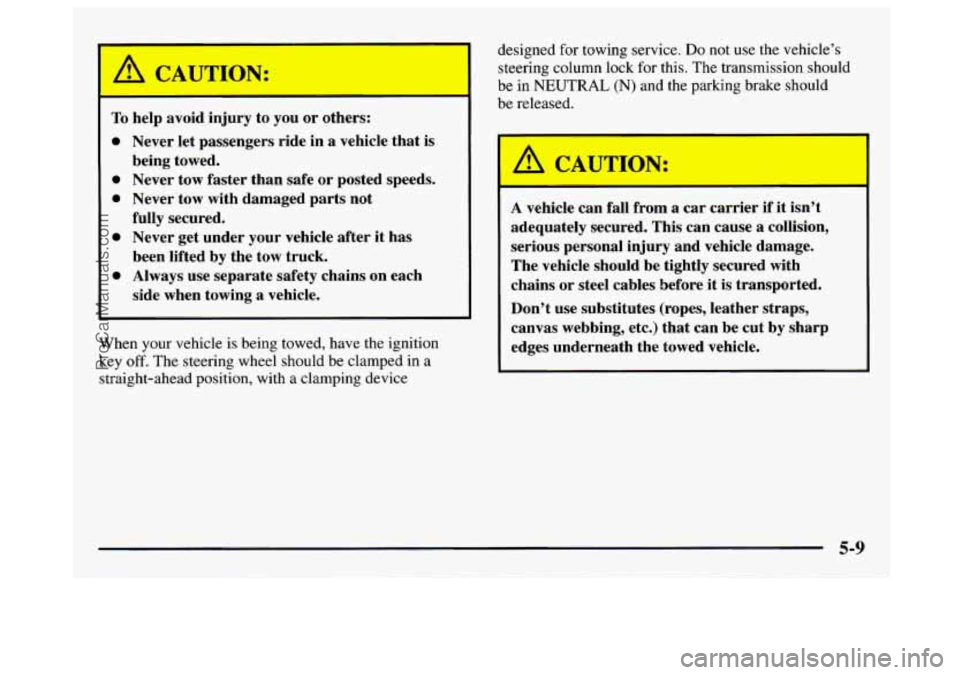
A CAUTION:
I
To help avoid injury to you or others:
0 Never let passengers ride in a vehicle that is
0 Never tow faster than safe or posted speeds.
0 Never tow with damaged parts not
0 Never get under your vehicle after .it has
0 Always use separate safety chains on each
being towed.
fully secured.
been lifted by the tow truck.
side when towing a vehicle.
When your vehicle is being towed, have the ignition
key
off. The steering wheel should be clamped in a
straight-ahead position, with a clamping device designed
for towing service.
Do not use the vehicle’s
steering column lock for this. The transmission should
be in
NEUTRAL (N) and the parking brake should
be released.
A CAUTION:
A vehicle can fall from a car carrier if it isn’t
adequately secured. This can cause
a collision,
serious personal injury and vehicle damage.
The vehicle should be tightly secured with
chains
or steel cables before it is transported.
Don’t use substitutes (ropes, leather straps,
canvas webbing, etc.) that can be cut by sharp
edges underneath the towed vehicle.
5-9
ProCarManuals.com
Page 204 of 388
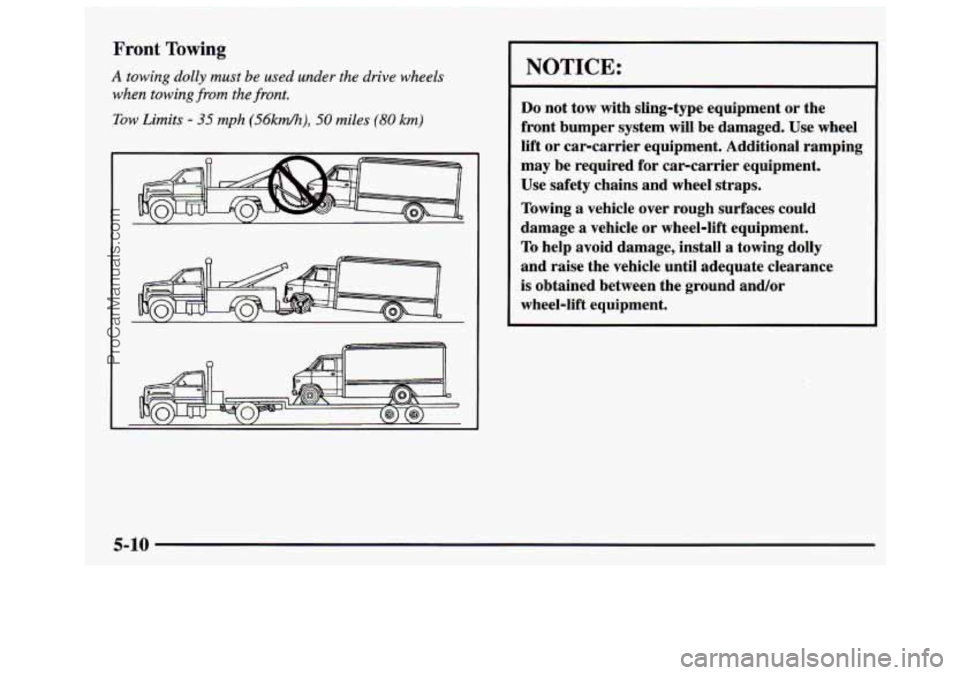
Front Towing
A towing dully must be used under the drive wheels
when towing from the front.
Tow Limits
- 35 mph (%kwh), 50 miles (80 km)
NOTICE:
Do not tow with sling-type equipment or the
front bumper system will, be damaged. Use wheel
lift or car-carrier equipment. Additional ramping
may be required for car-carrier equipment.
Use safety chains and wheel straps.
Towing a vehicle over rough surfaces could
damage a vehicle or wheel-lift equipment.
To help avoid damage, install a towing dolly
and raise the vehicle until adequate clearance
is obtained between the ground and/or
wheel-lift equipment.
5-10
ProCarManuals.com
Page 205 of 388
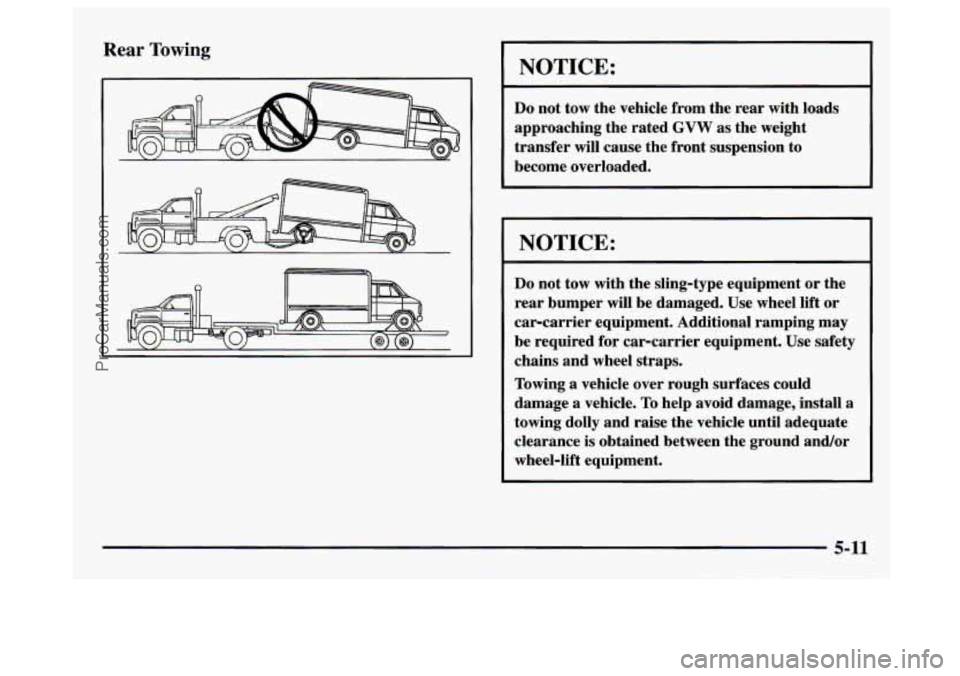
Rear Towing
I NOTICE:
Do not tow the vehicle from the rear with loads
approaching the rated
GVW as the weight
transfer will cause the front suspension to
become overloaded.
NOTICE:
Do not tow with the sling-type equipment or the
rear bumper will be damaged. Use wheel lift or
carcarrier equipment. Additional ramping may
be required for car-carrier equipment. Use safety
chains and wheel straps.
Towing
a vehicle over rough surfaces could
damage a vehicle.
To help avoid damage, install a
towing dolly and raise the vehicle until adequate
clearance is obtained between the ground and/or
wheel-lift equipment.
5-11
ProCarManuals.com
Page 206 of 388
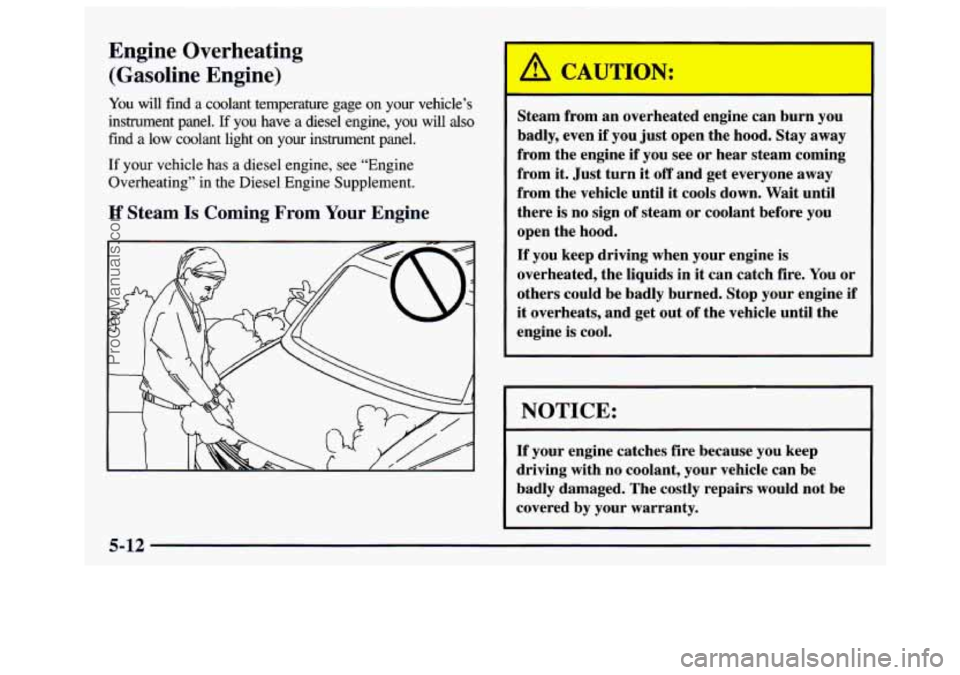
Engine Overheating
(Gasoline Engine)
You will find a coolant temperature gage on your vehicle’s
instrument panel.
If you have a diesel engine, you will also
find a low coolant light on your instrument panel.
If your vehicle has a diesel engine, see “Engine
Overheating” in the Diesel Engine Supplement.
If Steam Is Coming From Your Engine
Steam from an overheated engine can burn you
badly, even if you just open the hood. Stay away
from the engine if you see or hear steam coming
from it. Just turn it
off and get everyone away
from the vehicle until it cools down. Wait until
there is no sign of steam or coolant before you
open the hood.
If you keep driving when your engine is
overheated, the liquids in it can catch fire. You or
others could be badly burned. Stop your engine if
it overheats, and get out of the vehicle until the
engine is cool.
I NOTICE:
If your engine catches fire because you keep
driving with no coolant, your vehicle can be
badly damaged. The costly repairs would not be
covered by your warranty.
5-12
ProCarManuals.com
Page 207 of 388
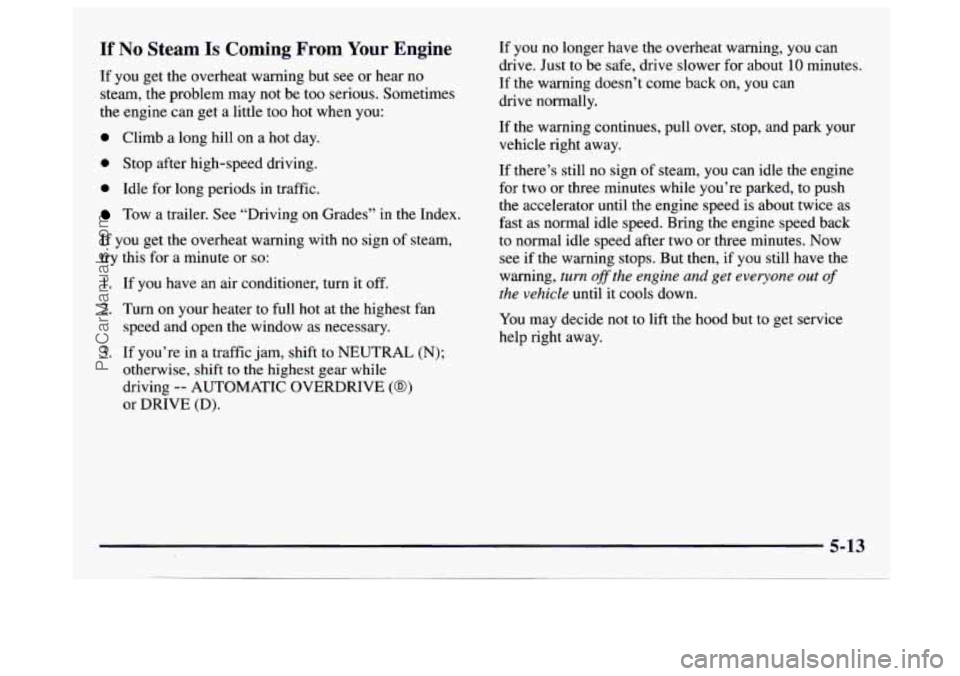
If No Steam Is Coming From Your Engine
If you get the overheat warning but see or hear no
steam, the problem may not be too serious. Sometimes
the engine can get a little too hot when you:
0 Climb a long hill on a hot day.
0 Stop after high-speed driving.
0 Idle for long periods in traffic.
Tow a trailer. See “Driving on Grades” in the Index.
If you get the overheat warning with no sign of steam,
try this for a minute or
so:
1. If you have an air conditioner, turn it off.
2. Turn on your heater to full hot at the highest fan
3. If you’re in a traffic jam, shift to NEUTRAL (N);
otherwise, shift to
the highest gear while
driving
-- AUTOMATIC OVERDRIVE (a)
or DRIVE (D). speed and
open the window as necessary. If you no
longer have the overheat warning, you can
drive. Just to be safe, drive slower for about 10 minutes.
If
the warning doesn’t come back on, you can
drive normally.
If the warning continues, pull over, stop, and park your
vehicle right away.
If there’s still no sign of steam, you can idle the engine
for two or three minutes while you’re parked, to push
the accelerator until the engine speed is about twice as
fast as normal idle speed. Bring the engine speed back
to normal idle speed after two or three minutes. Now
see if the warning stops. But then, if you still have the
warning,
turn ofithe engine and get everyone out of
the vehicle until it cools down.
You may decide not to lift the hood but to get service
help right away.
5-13
ProCarManuals.com
Page 208 of 388
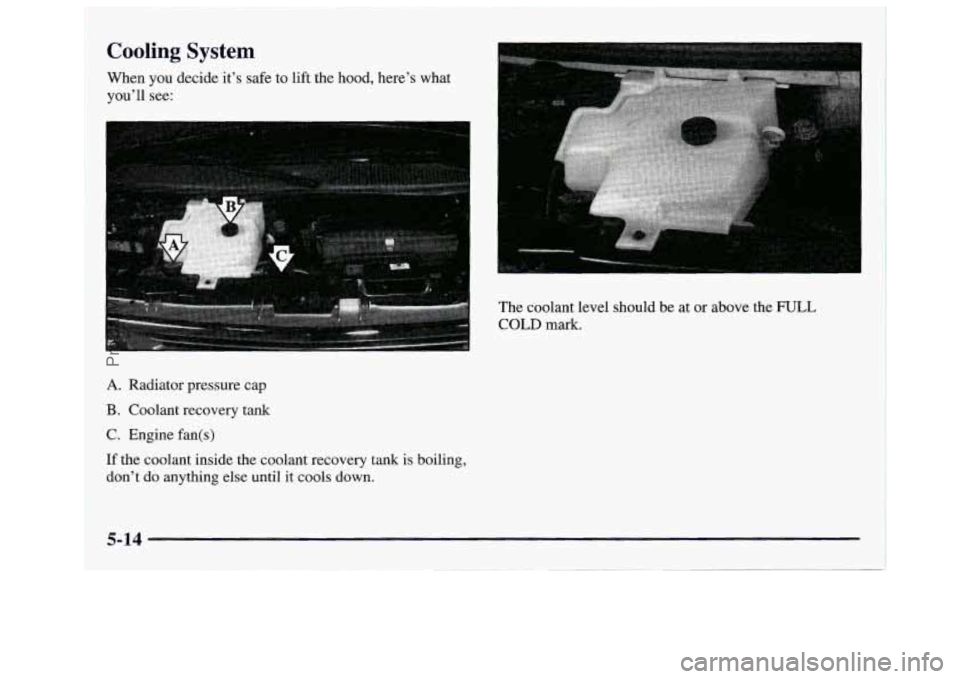
Cooling System
When you decide it’s safe to lift the hood, here’s what
you’ll see:
The coolant level should be at or above the
FULL
COLD mark.
A. Radiator pressure cap
B. Coolant recovery tank
C. Engine fan(s)
If the coolant inside the coolant recovery tank is boiling,
don’t do anything else until it cools down.
5-14
I I
ProCarManuals.com
Page 209 of 388
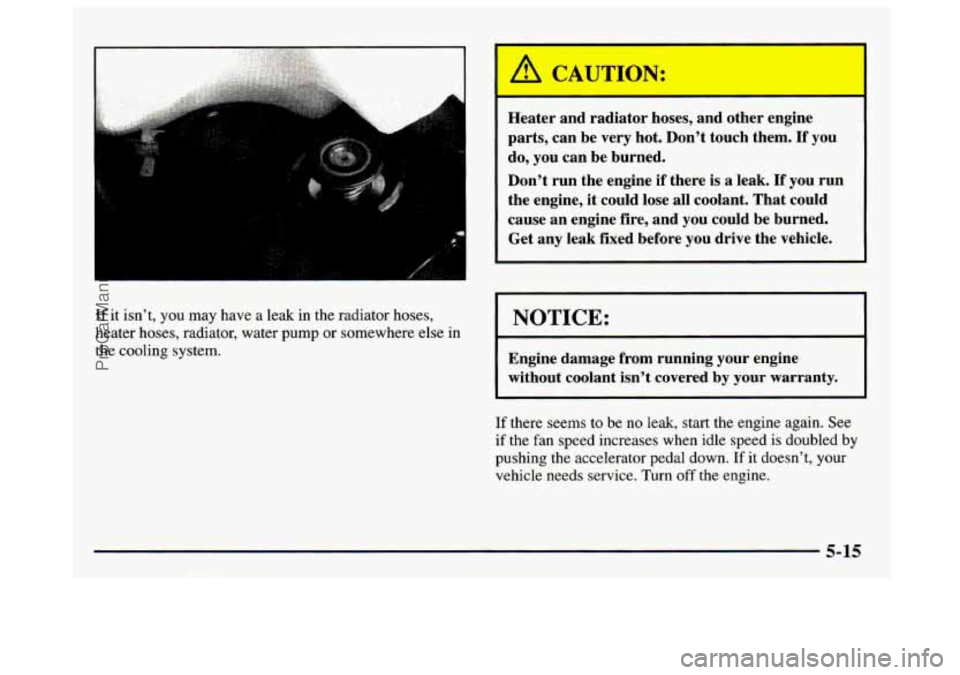
If it isn’t, you may have a leak in the radiator hoses,
heater hoses, radiator, water pump or somewhere else in
the cooling system.
A CAUTION:
Heater and radiator hoses, and other engine
parts, can be very hot. Don’t touch them.
If you
do, you can be burned.
Don’t run the engine
if there is a leak. If you run
the engine, it could lose a11 coolant. That could
cause an engine fire, and
you could be burned.
Get any leak fixed before
you drive the vehicle.
NOTICE:
Engine damage from running your engine
without coolant isn’t covered
by your warranty.
If there seems to be no leak, start the engine again. See
if the fan speed increases when idle speed is doubled by
pushing the accelerator pedal down.
If it doesn’t, your
vehicle needs service. Turn off the engine.
5-15
ProCarManuals.com
Page 210 of 388
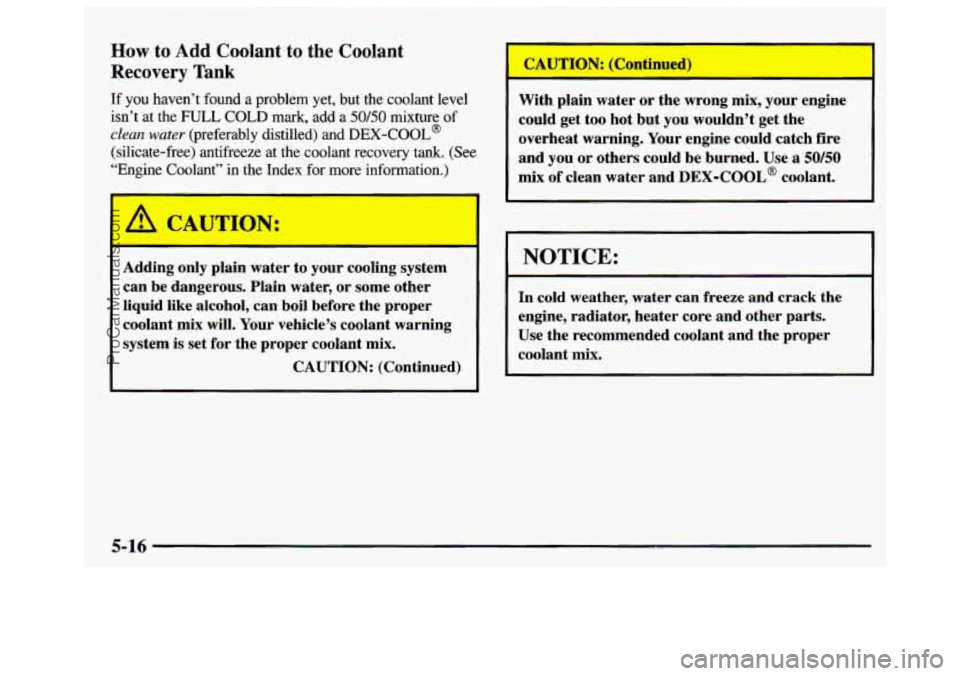
How to Add Coolant to the Coolant
Recovery Tank
If you haven’t found a problem yet, but the coolant level
isn’t at the
FULL COLD mark, add a 50/50 mixture of
clean water (preferably distilled) and DEX-COOL@
(silicate-free) antifreeze
at the coolant recovery tank. (See
“Engine Coolant” in the Index for more information.)
Adding only plain
can be dangerous. Plain water,
or some other
liquid like alcohol, can boil before the proper
coolant mix will, Your vehicle’s coolant warning
system is set for the proper coolant mix.
CAUTION: (Continued) JAUTION:
(Continu
With plain water or the wrong’mix, your engine
could get too hot but you wouldn’t get the
overheat warning. Your engine could catch fire
and you or others could be burned. Use
a 50/50
mix of clean water and DEX-COOL@ coolant.
NOTICE:
In cold weather, water can freeze and crack the
engine, radiator, heater core and other parts.
Use the recommended coolant and the proper
coolant mix.
5-16
ProCarManuals.com